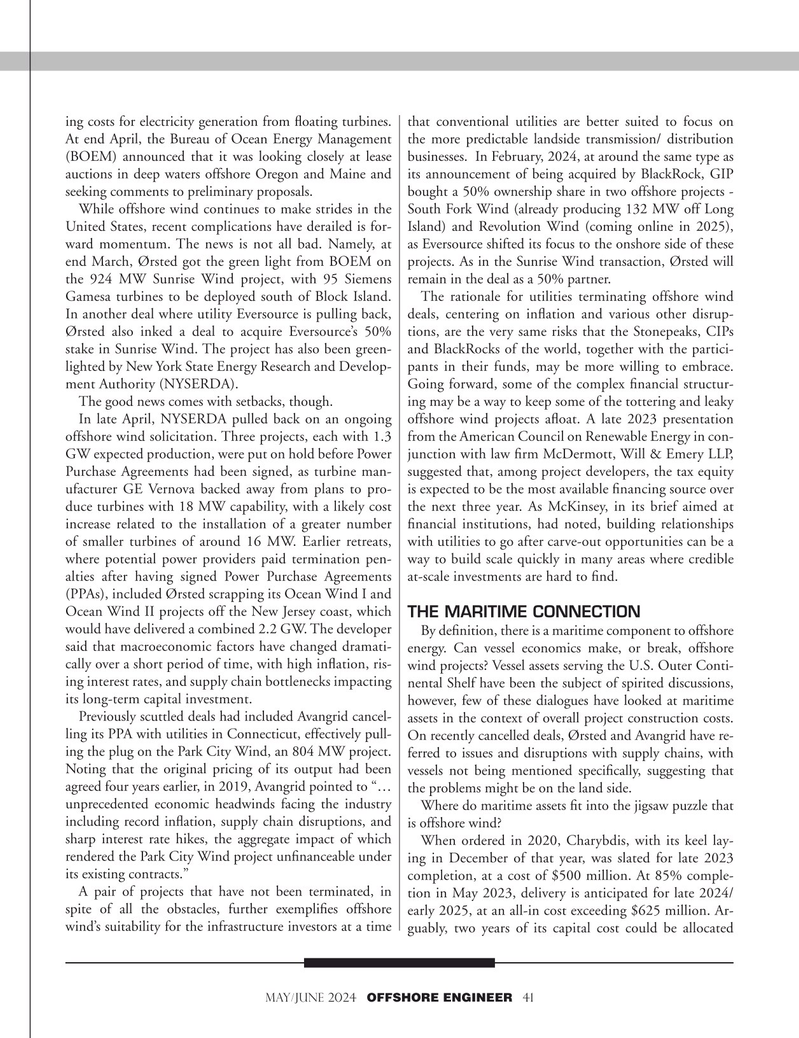
Page 41: of Offshore Engineer Magazine (May/Jun 2024)
Read this page in Pdf, Flash or Html5 edition of May/Jun 2024 Offshore Engineer Magazine
ing costs for electricity generation from foating turbines. that conventional utilities are better suited to focus on
At end April, the Bureau of Ocean Energy Management the more predictable landside transmission/ distribution (BOEM) announced that it was looking closely at lease businesses. In February, 2024, at around the same type as auctions in deep waters offshore Oregon and Maine and its announcement of being acquired by BlackRock, GIP seeking comments to preliminary proposals. bought a 50% ownership share in two offshore projects -
While offshore wind continues to make strides in the South Fork Wind (already producing 132 MW off Long
United States, recent complications have derailed is for- Island) and Revolution Wind (coming online in 2025), ward momentum. The news is not all bad. Namely, at as Eversource shifted its focus to the onshore side of these end March, Ørsted got the green light from BOEM on projects. As in the Sunrise Wind transaction, Ørsted will the 924 MW Sunrise Wind project, with 95 Siemens remain in the deal as a 50% partner.
Gamesa turbines to be deployed south of Block Island. The rationale for utilities terminating offshore wind
In another deal where utility Eversource is pulling back, deals, centering on infation and various other disrup-
Ørsted also inked a deal to acquire Eversource’s 50% tions, are the very same risks that the Stonepeaks, CIPs stake in Sunrise Wind. The project has also been green- and BlackRocks of the world, together with the partici- lighted by New York State Energy Research and Develop- pants in their funds, may be more willing to embrace. ment Authority (NYSERDA). Going forward, some of the complex fnancial structur-
The good news comes with setbacks, though. ing may be a way to keep some of the tottering and leaky
In late April, NYSERDA pulled back on an ongoing offshore wind projects afoat. A late 2023 presentation offshore wind solicitation. Three projects, each with 1.3 from the American Council on Renewable Energy in con-
GW expected production, were put on hold before Power junction with law frm McDermott, Will & Emery LLP,
Purchase Agreements had been signed, as turbine man- suggested that, among project developers, the tax equity ufacturer GE Vernova backed away from plans to pro- is expected to be the most available fnancing source over duce turbines with 18 MW capability, with a likely cost the next three year. As McKinsey, in its brief aimed at increase related to the installation of a greater number fnancial institutions, had noted, building relationships of smaller turbines of around 16 MW. Earlier retreats, with utilities to go after carve-out opportunities can be a where potential power providers paid termination pen- way to build scale quickly in many areas where credible alties after having signed Power Purchase Agreements at-scale investments are hard to fnd.
(PPAs), included Ørsted scrapping its Ocean Wind I and
Ocean Wind II projects off the New Jersey coast, which
THE MARITIME CONNECTION would have delivered a combined 2.2 GW. The developer
By defnition, there is a maritime component to offshore said that macroeconomic factors have changed dramati- energy. Can vessel economics make, or break, offshore cally over a short period of time, with high infation, ris- wind projects? Vessel assets serving the U.S. Outer Conti- ing interest rates, and supply chain bottlenecks impacting nental Shelf have been the subject of spirited discussions, its long-term capital investment.
however, few of these dialogues have looked at maritime
Previously scuttled deals had included Avangrid cancel- assets in the context of overall project construction costs. ling its PPA with utilities in Connecticut, effectively pull-
On recently cancelled deals, Ørsted and Avangrid have re- ing the plug on the Park City Wind, an 804 MW project. ferred to issues and disruptions with supply chains, with
Noting that the original pricing of its output had been vessels not being mentioned specifcally, suggesting that agreed four years earlier, in 2019, Avangrid pointed to “… the problems might be on the land side. unprecedented economic headwinds facing the industry
Where do maritime assets ft into the jigsaw puzzle that including record infation, supply chain disruptions, and is offshore wind?
sharp interest rate hikes, the aggregate impact of which
When ordered in 2020, Charybdis, with its keel lay- rendered the Park City Wind project unfnanceable under ing in December of that year, was slated for late 2023 its existing contracts.” completion, at a cost of $500 million. At 85% comple-
A pair of projects that have not been terminated, in tion in May 2023, delivery is anticipated for late 2024/ spite of all the obstacles, further exemplifes offshore early 2025, at an all-in cost exceeding $625 million. Ar- wind’s suitability for the infrastructure investors at a time guably, two years of its capital cost could be allocated
MAy/june 2024 OFFSHORE ENGINEER 41

 40
40

 42
42